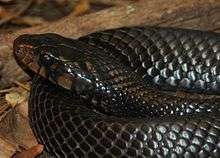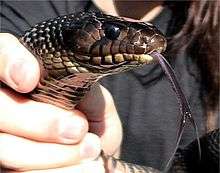Drymarchon
| Drymarchon | |
|---|---|
 | |
| Drymarchon couperi, eastern indigo snake | |
| Scientific classification | |
| Kingdom: | Animalia |
| Phylum: | Chordata |
| Subphylum: | Vertebrata |
| Class: | Reptilia |
| Order: | Squamata |
| Suborder: | Serpentes |
| Family: | Colubridae |
| Subfamily: | Colubrinae |
| Genus: | Drymarchon Fitzinger, 1843 |
| Species and subspecies | |
|
D. caudomaculatus | |
| Synonyms | |
|
Coluber, Compsosoma, Georgia, Spilotes [1] | |
Drymarchon is a genus of large nonvenomous colubrid snakes, commonly known as indigo snakes, endemic to the Southeastern United States, Central America, and South America. Three to four species are currently recognized.[2]
Description
Indigo snakes are large, robust snakes which can reach a length of over 3 m (9.8 ft). They have smooth dorsal scales with several color variations, including a glossy blue-black color.
Behavior and diet
Indigo snakes are diurnal and actively forage for prey. They feed on a broad variety of small animals such as rodents, birds, lizards, frogs, toads, and other snakes, including rattlesnakes. They are not aggressive snakes and will only bite when threatened. Typical threat display includes hissing and shaking of its tail as a warning.
Species
The genus Drymarchon was formerly considered to be a monotypic taxon formed by subspecies of D. corais. Currently the genus includes three distinct species recognized by ITIS:[2]
- Indigo snake — Drymarchon corais (F. Boie, 1827)
- Eastern indigo snake — Drymarchon couperi (Holbrook, 1842)[3]
- Middle American indigo snake — Drymarchon melanurus (A.M.C. Duméril, Bibron & A.H.A. Duméril, 1854)
- Texas indigo snake — Drymarchon melanurus erebennus (Cope, 1860)[4]
- Mexican red-tailed indigo snake — Drymarchon melanurus rubidus H.M. Smith, 1941
A fourth species, found in Venezuela, has been proposed by Wüster, Yrausquin, and Mijares-Urrutia:[5][6]
- Falcon indigo snake — Drymarchon caudomaculatus Wüster, Yrausquin & Mijares-Urrutia, 2001
References
- ↑ Wright, A.H., and A.A. Wright. 1957. Handbook of Snakes of the United States and Canada. Comstock. Ithaca and London. 1,105 pp. (in 2 volumes) (Drymarchon, p. 200.)
- 1 2 "Drymarchon". Integrated Taxonomic Information System. Retrieved 2011-02-06.
- ↑ Hammerson, G.A (2007). "Drymarchon couperi". IUCN Red List of Threatened Species. Version 2010.1. International Union for Conservation of Nature. Retrieved 8 February 2011.
- ↑ Lee, J., Calderón Mandujano, R., Lopez-Luna, M.A., Vasquez Díaz, J. & Quintero Díaz, G.E. (2007). "Drymarchon melanurus". IUCN Red List of Threatened Species. Version 2010.4. International Union for Conservation of Nature. Retrieved 8 February 2011.
- ↑ Genus Drymarchon at The Reptile Database
- ↑ Wüster, Wolfgang; José Luís Yrausquin; Abraham Mijares-Urrutia (2001). "A new species of indigo snake from north-western Venezuela (Serpentes: Colubridae: Drymarchon)" (PDF). Herpetological Journal 11: 157–165.
Further reading
- Fitzinger, L. 1843. Systema Reptilium, Fasciculus Primus, Amblyglossae. Braumüller & Seidel. Vienna. 106 pp. (Drymarchon, p. 26.)
External links
| Wikispecies has information related to: Drymarchon |
| Wikimedia Commons has media related to Drymarchon. |
- The Indigo Snake Systematics Page: A New Species of Indigo Snake (Drymarchon) from Venezuela, and a Reclassification of the Genus.
- "Black Snakes": Identification and Ecology - University of Florida fact sheet
